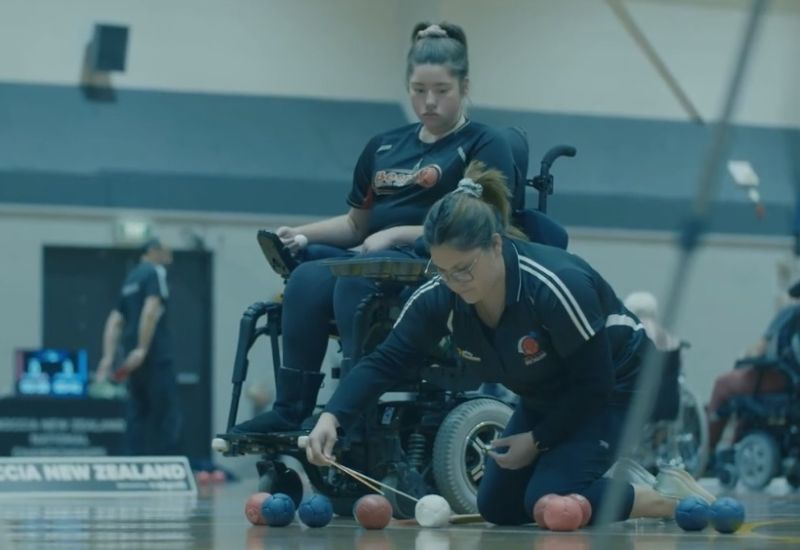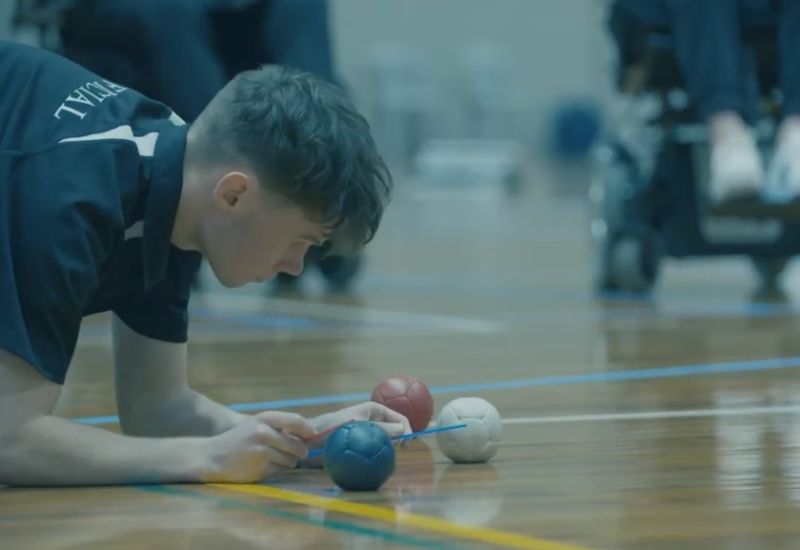Boccia is a precision ball sport played by athletes with disabilities, requiring accuracy and strategic thinking. Boccia is a precision ball sport that challenges athletes with disabilities to display accuracy and strategic thinking.
Played across the globe, it offers intense competition and showcases the athletes’ skills and abilities. Boccia is distinct because it is adaptable for various disabilities, making it an inclusive sport.
The sport originated in Greece but has evolved to become a prominent Paralympic event.
Boccia is played indoors on a court, usually made of a synthetic surface, with athletes aiming to throw or roll their balls as close as possible to a target ball.
It requires exceptional concentration, precision, and decision-making skills. Boccia is not just a sport; it is a platform that promotes inclusivity and showcases the incredible abilities of athletes with disabilities.
History Of Boccia
Boccia is a unique Paralympic sport that requires skills, strategy, and precision. Players aim to roll, throw, or kick leather balls as close as possible to a target ball.
It is a highly competitive and inclusive sport suitable for athletes with severe disabilities.
Origin Of Boccia
Boccia, a game that has captured the hearts of many athletes and sports enthusiasts around the world, has an intriguing history that dates back centuries.
The origins of this sport can be traced to ancient Greece, where a similar game called ‘boules’ was popular. However, it wasn’t until the 20th century that Boccia as we know it today started to take shape.

According to historical records, Boccia originated in Italy and was initially played by individuals with limited mobility, such as those with cerebral palsy.
The game provided an opportunity for them to participate in a competitive sport on an equal footing. Over time, Boccia gained recognition as a Paralympic event, and its popularity spread globally.
Evolution Of Boccia
Over the years, Boccia has evolved from its humble beginnings to become a highly competitive and skill-based sport.
Initially, the game was played using natural, leather Boccia balls. However, as the sport grew in popularity, advancements in technology led to the development of more specialized equipment.
Modern Boccia balls are made of synthetic materials, which provide enhanced grip and control.
The evolution of equipment has not only improved the overall playing experience but has also allowed athletes to showcase their strategic skills and precision.
Furthermore, the rules of Boccia have been refined to ensure fair and equal competition. The game is played on a flat, smooth surface, and participants aim to throw their balls as close as possible to a target ball known as the ‘jack.’
Players use their hands, feet, or assistive devices, such as ramps, to release the balls. Each match consists of several rounds, and the athlete or team with the most balls closest to the jack at the end wins the round.
Boccia has come a long way since its inception, transforming into a sport that provides people with disabilities a platform to compete at an elite level and showcase their skills.
With its rich history and constant evolution, Boccia has truly become an inclusive and exciting sport that continues to captivate both athletes and spectators alike.
Rules And Gameplay
Boccia is a unique and engaging sport that is played by individuals with severe disabilities. It is a precision ball sport that requires both strategy and finesse.
Objective Of The Game
The objective of Boccia is to score points by getting your balls as close as possible to the target ball, called the jack. The game is played by two individuals, or teams of three, who take turns to throw, roll, or kick their colored balls towards the jack, which is initially thrown by the referee.
The closer a player’s ball is to the jack, the more points they score. The player or team with the most points at the end of the game wins.
Equipment Used
To play Boccia, you will need specialized equipment. The balls used in Boccia are made of leather and are slightly larger than a tennis ball. There are two sets of balls, each set containing six balls of the same color.
In addition to the balls, a white target ball, or jack, is used as the target for the players to aim for. A Boccia court is also required, which is a flat, rectangular area marked with boundaries to determine the playing area.
How To Play Boccia
Boccia is played in a series of rounds, and each round consists of six balls. The player who has won the previous round starts the next round by throwing or rolling the jack onto the court. Then, the same player throws their first ball towards the jack, trying to get it as close as possible.
The next player then tries to get their ball closer to the jack than the previous player’s ball. This continues until all the balls have been thrown.
Players can use a ramp or their feet to release the balls if they have limited upper-body mobility. The game requires a combination of skill, strategy, and precision.
Players need to strategically position their balls to make it difficult for their opponents to score points. At the end of each round, points are awarded to the player or team with the ball closest to the jack.
The game continues until a predetermined number of rounds have been played, or until a player or team reaches a specific score.
Playing Boccia requires focus, concentration, and great control. It is a sport that not only offers physical challenges but also promotes strategic thinking and sportsmanship.
Whether you are a beginner or an experienced player, Boccia is a game that can be enjoyed by people of all abilities.
Boccia As A Paralympic Sport
Boccia is a sport that has gained widespread recognition and popularity as a Paralympic event. It is a unique and captivating sport that is played by individuals with severe disabilities, such as cerebral palsy, muscular dystrophy, or other conditions that affect motor skills and coordination.
Boccia provides an inclusive platform where athletes with disabilities can showcase their skills, athleticism, and competitive spirit. In this article, we will explore the inclusion of boccia in the Paralympics, the classification system used, and the impact it has on athletes.

Boccia was first introduced as a Paralympic sport in 1984. Since then, it has become one of the most anticipated and watched events of the Paralympic Games.
The inclusion of boccia in the Paralympics has provided athletes with severe disabilities a platform to compete at the highest level and gain recognition for their dedication and skill.
Boccia’s presence in the Paralympics has also played a crucial role in promoting inclusivity and breaking down barriers for individuals with disabilities.
By showcasing the sport on a global stage, the Paralympics have increased awareness and understanding of disability sports, fostering a more inclusive and accepting society.
Boccia employs an extensively developed classification system to ensure fair competition among athletes with various levels of impairment.
The classification system categorizes athletes into different classes based on their functional abilities. These classes range from BC1 to BC8, with BC1 being for athletes with the greatest level of impairment and BC8 for those with the least.
| Class | Description |
|---|---|
| BC1 | Athletes with moderate-to-severe physical impairments affect their upper and lower limbs. |
| BC2 | Athletes with severe physical impairments affecting their upper and lower limbs, require assistive devices. |
| BC3 | Athletes with minimal physical impairments affect their upper and lower limbs. |
| BC4 | Athletes with moderate physical impairments affecting their upper and lower limbs, using assistive devices. |
| BC5-8 | Athletes with minimal physical impairments affecting their upper and lower limbs. |
Boccia’s inclusion as a Paralympic sport has had a profound impact on athletes who participate in the game.
For athletes with disabilities, boccia provides an avenue to channel their abilities, showcase their talents, and compete at an elite level.
Regardless of their impairment, boccia provides a level playing field, where success is determined by individual skill, strategy, and focus.
- The sport promotes physical activity, helping athletes improve their motor skills and coordination. Through dedicated training and practice, boccia players enhance their physical abilities, contributing to their overall well-being.
- Boccia also cultivates mental resilience and strategic thinking. Athletes must assess their opponents’ moves, adapt their strategies accordingly, and make precise shots to secure points.
- Furthermore, participating in boccia enhances social inclusion by building a sense of camaraderie and teamwork among athletes with disabilities. It provides a supportive and encouraging environment where athletes can form lifelong friendships and connections.
Boccia’s incorporation as a Paralympic sport has been a significant step towards inclusivity and breaking barriers for individuals with disabilities.
The classification system ensures fair competition among athletes with different abilities, while the sport itself promotes physical and mental growth, as well as social inclusion.
As the Paralympics continue to gain global attention, boccia will undoubtedly play a vital role in inspiring athletes, spectators, and society at large.
Final Thoughts
Boccia is a unique and inclusive sport that offers a thrilling and competitive experience for athletes with severe disabilities. With its origins rooted in Greek antiquity, the game has evolved into a Paralympic sport that showcases precision, strategy, and skill.
Whether played recreationally or competitively, boccia provides individuals of all abilities with a chance to engage in physical activity, foster social connections, and embrace the spirit of inclusivity.